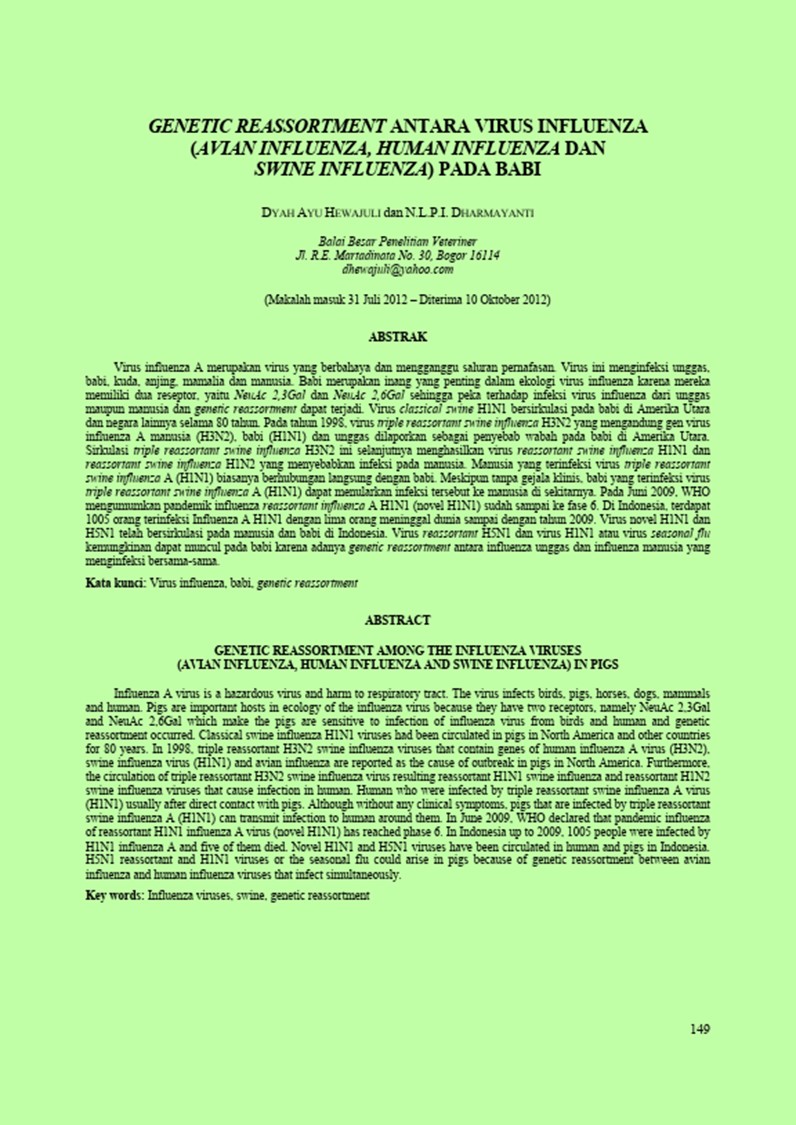
| Judul | GENETIC REASSORTMENT ANTARA VIRUS INFLUENZA (AVIAN INFLUENZA, HUMAN INFLUENZA DAN SWINE INFLUENZA) PADA BABI / DYAH AYU HEWAJULI |
| Pengarang | DYAH AYU HEWAJULI N.L.P.I. DHARMAYANTI |
| EDISI | Vol. 22 No. 4 |
| Penerbitan | Balai Besar Penelitian Veteriner : WARTAZOA, 2012 |
| Deskripsi Fisik | 12 |
| Subjek | GENETIC REASSORTMENT |
| Abstrak | Influenza A virus is a hazardous virus and harm to respiratory tract. The virus infects birds, pigs, horses, dogs, mammals and human. Pigs are important hosts in ecology of the influenza virus because they have two receptors, namely NeuAc 2,3Gal and NeuAc 2,6Gal which make the pigs are sensitive to infection of influenza virus from birds and human and genetic reassortment occurred. Classical swine influenza H1N1 viruses had been circulated in pigs in North America and other countries for 80 years. In 1998, triple reassortant H3N2 swine influenza viruses that contain genes of human influenza A virus (H3N2), swine influenza virus (H1N1) and avian influenza are reported as the cause of outbreak in pigs in North America. Furthermore, the circulation of triple reassortant H3N2 swine influenza virus resulting reassortant H1N1 swine influenza and reassortant H1N2 swine influenza viruses that cause infection in human. Human who were infected by triple reassortant swine influenza A virus (H1N1) usually |
| Bentuk Karya | Tidak ada kode yang sesuai |
| Target Pembaca | Tidak ada kode yang sesuai |
| No Barcode | No. Panggil | Akses | Lokasi | Ketersediaan |
|---|---|---|---|---|
| ARTVET2451 | ARTVET2451 | Dapat dipinjam | Perpustakaan Balai Besar Perakitan dan Modernisasi Veteriner - Ruang Baca Umum | Tersedia |
| Tag | Ind1 | Ind2 | Isi |
| 001 | INLIS000000000019151 | ||
| 005 | 20250204112434 | ||
| 007 | ta | ||
| 008 | 250204################|##########|#|## | ||
| 035 | # | # | $a 0010-0924000230 |
| 082 | # | # | $a ARTVET2451 |
| 084 | # | # | $a ARTVET2451 |
| 100 | 0 | # | $a DYAH AYU HEWAJULI |
| 245 | 1 | # | $a GENETIC REASSORTMENT ANTARA VIRUS INFLUENZA (AVIAN INFLUENZA, HUMAN INFLUENZA DAN SWINE INFLUENZA) PADA BABI /$c DYAH AYU HEWAJULI |
| 250 | # | # | $a Vol. 22 No. 4 |
| 260 | # | # | $a Balai Besar Penelitian Veteriner :$b WARTAZOA,$c 2012 |
| 300 | # | # | $a 12 |
| 520 | # | # | $a Influenza A virus is a hazardous virus and harm to respiratory tract. The virus infects birds, pigs, horses, dogs, mammals and human. Pigs are important hosts in ecology of the influenza virus because they have two receptors, namely NeuAc 2,3Gal and NeuAc 2,6Gal which make the pigs are sensitive to infection of influenza virus from birds and human and genetic reassortment occurred. Classical swine influenza H1N1 viruses had been circulated in pigs in North America and other countries for 80 years. In 1998, triple reassortant H3N2 swine influenza viruses that contain genes of human influenza A virus (H3N2), swine influenza virus (H1N1) and avian influenza are reported as the cause of outbreak in pigs in North America. Furthermore, the circulation of triple reassortant H3N2 swine influenza virus resulting reassortant H1N1 swine influenza and reassortant H1N2 swine influenza viruses that cause infection in human. Human who were infected by triple reassortant swine influenza A virus (H1N1) usually after direct contact with pigs. Although without any clinical symptoms, pigs that are infected by triple reassortant swine influenza A (H1N1) can transmit infection to human around them. In June 2009, WHO declared that pandemic influenza of reassortant H1N1 influenza A virus (novel H1N1) has reached phase 6. In Indonesia up to 2009, 1005 people were infected by H1N1 influenza A and five of them died. Novel H1N1 and H5N1 viruses have been circulated in human and pigs in Indonesia. H5N1 reassortant and H1N1 viruses or the seasonal flu could arise in pigs because of genetic reassortment between avian influenza and human influenza viruses that infect simultaneously. |
| 650 | # | 4 | $a GENETIC REASSORTMENT |
| 700 | 0 | # | $a N.L.P.I. DHARMAYANTI |
| 990 | # | # | $a ARTVET2451 |
| No | Nama File | Nama File Format Flash | Format File | Action |
| 1 | 1872.pdf | ARTVET1872 | Baca Online |
Content Unduh katalog
Karya Terkait :